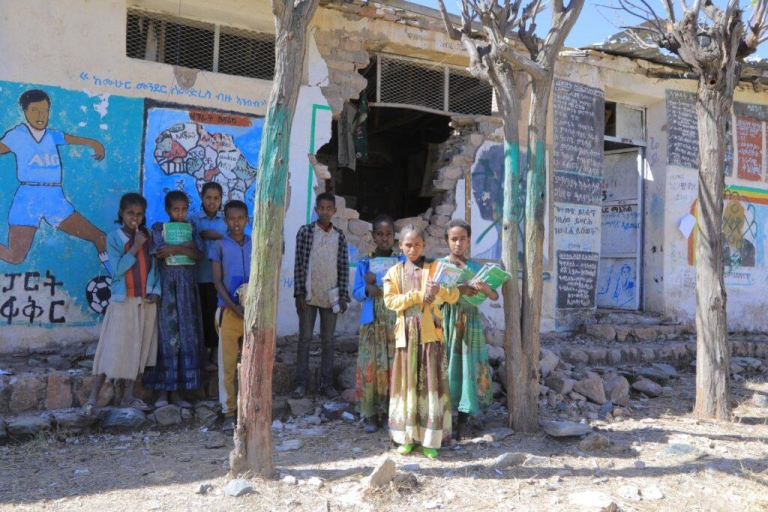Mekelle, Tigray – In Wereda Tselemti, North Western Tigray, the deserted classrooms and shuttered schools that once served as centers of learning for tens of thousands of children are a stark reminder of the toll the war has taken on the Tigray’s education system. For over five years, 79 educational institutions in the district have been closed, leaving approximately 56,000 students without access to formal education, according to Tselemti development association.
Children now spend their days helping with household chores, tending livestock, working in fields or searching for food, rather than learning math, science or reading, as teachers have either been killed, displaced, or remain unpaid.
The situation in Tselemti reflects a broader crisis in Tigray. Across Tigray, schools have been reduced to rubble, with roofs collapsed, libraries looted and laboratories stripped of equipment. A 2023 report by the UNOCHA, showed that more than 85% of schools were damaged or destroyed during the war. Some were burned, others used as barracks by fighters and many still bear bullet holes and shell scars.
According to the latest report by the regional education bureau, this year alone 1.2 million children are out of school due to many factors including economic hardship and lack of access to education. In rural areas, where schools were already under-resourced before the war, the closures have pushed families back decades. The human toll is just as severe. The Tigray regional education bureau has reported that 14,000 teachers have died as a direct or indirect result of the war on Tigray and the bureau estimates that the education system has sustained $1.6 billion in damage and in areas where schools are technically open, they often operate in extreme conditions. Some lack chairs, blackboards or even walls. Others run double or triple shifts, trying to squeeze hundreds of students into a single classroom.
In addition to the school conditions, economic hardship and accessibility have also become crippling barriers. Many families, economically drained by the two years of war, cannot afford basics such as notebooks, uniforms, or food for their children as a result many are often pulled from school to help support household survival, working in fields, herding animals or fetching water for hours each day.
A Lost Generation in the Making
The collapse of Tigray’s education system is not just a temporary setback, it threatens to shape Tigray’s future for decades. Many warn that every year a child spends out of the classroom reduces their lifetime earnings potential and increases the likelihood of falling into poverty. A 2023 World Bank study on conflict-affected middle income countries found that a single year of lost schooling can reduce a child’s expected lifetime earnings by 9%. Multiplied across a generation, the missed education in Tigray could set back Tigray’s recovery by decades, undermining its workforce, productivity and chances of long-term stability.
The risks go beyond illiteracy. Children who miss years of schooling are more likely to end up in child labor, early marriage, or unsafe migration. In many parts of rural Tigray, families say their children are dropping out to work as daily laborers or they are drawn into dangerous migration, where many fall prey to human traffickers.
“My son used to dream of being a doctor,” said Selam, a mother of three in Axum. “Now he says he wants to go to Europe to find work. He doesn’t believe in school anymore.”
Desperate teenagers are lured by promises of jobs and better life abroad, only to end up stranded or exploited in Yemen, Libya or along desert smuggling routes.
The psychological toll is equally severe. Many children witnessed violence firsthand during the war, killings, displacement, hunger and without the routine and stability that schools provide, trauma goes untreated. Teachers describe students struggling with attention, discipline, and even basic communication.
Girls Pay the Highest Price
While the war has upended education for all children in Tigray, girls have borne a disproportional burden. Alemat Amare, the deputy head of Tigray’s Women affairs bureau told Wegahta that among the children who haven’t returned back to school, around 50% of them are girls. According to Alemat many have been pushed out of the classroom due to poverty, family responsibilities, and economic hardship intensified by war.
Child marriage across Tigray is reportedly rising, as desperate families marry off daughters to reduce household expenses. For many girls, marriage is becoming a survival strategy, even if it means abandoning education forever. These girls are losing not just their schooling, but their childhoods and the ripple effects are severe. Girls who leave school are far less likely to return, trapping them in cycles of domestic labor, dependency or early marriage and motherhood.
Many fear that this could undo years of slow but steady progress toward gender parity in education in Tigray.
Rebuilding from Ashes
Even amid devastation, there have been efforts to rebuild Tigray’s shattered education system. According to the Tigray Recovery and Reconstruction Coordination Office, in 2017 E.C. alone, 51 schools were reconstructed or rebuilt, restoring some classrooms and providing a measure of hope to affected communities.
But the scale of destruction far outpaces these efforts. With more than 85% of schools damaged or destroyed, the 51 rebuilt schools barely scratch the surface of what is needed. For every school reopened, dozens remain in ruins, forcing children to travel long distances or go without schooling entirely. The Tigray regional education bureau estimates that over $4.7 billion will be required to fully rebuild the education system.
Education as Collateral Damage
The war on Tigray, which began in November 2020, has exacted a devastating toll on Tigray’s civilian infrastructure and schools have borne a heavy share of the damage. While both the Federal government and its allies deny deliberately targeting educational institutions, evidence on the ground suggests that schools were frequently looted, occupied, or destroyed, becoming unintended or in many cases strategic victims of the war.
Reports indicate that classrooms were used as military barracks, storing weapons and housing soldiers, leaving them unfit for learning. Libraries were ransacked, laboratories stripped of equipment, and blackboards filled by a message of threats and intimidation. Children returned to find bullet-riddled walls and burned textbooks.
And the disruption goes beyond physical damage. Teachers have been killed, displaced, or left unpaid for months and many students have been forced into household labor to help families survive. In effect, the collapse of education has become both a cause and a consequence of the humanitarian crisis.
A Future on Hold
Across Tigray, children who once filled schoolyards with laughter now spend their days fetching water, tending livestock, or working in fields. Dreams of doctors, engineers, and teachers are being replaced with survival strategies. For many families, sending children back to school is not just difficult, it is impossible. Poverty coupled with destroyed infrastructure has made education become a luxury rather than a right.
For those who do return to classrooms, learning conditions are harsh. Overcrowded rooms, minimal supplies and underpaid or volunteer teachers make progress slow and precarious. As a result the fate of Tigray’s children now hangs in the balance. Each day without school is a day that diminishes their potential and by extension, the potential of Tigray itself.


